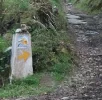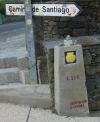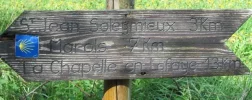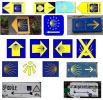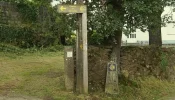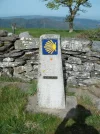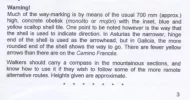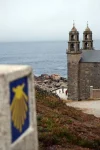I have just finished walking the last 100 km of the five routes into Santiago, and the shell rays on the wayposts with a tile insert always point in the direction of the turn or route in Galicia. Wayposts from Leon to Galicia are a pot pourri of styles without a noticeable information content in the shell.
On the
Camino Frances these wayposts are not common until about O Pino/Pedrouzo, and disappear again shortly after the Santiago airport. Most of the wayposts with a space for the tile do not have a tile. It either has not been installed, or has been taken as a souvenir.
From the 152 km distance marker before O Cebreiro the most common waypost is the distance marker. A lot of them have an arrow engraved in them, usually painted yellow and often with a spray paint arrow added to emphasize it. The ones without the embedded arrow provide direction guidance only if an arrow has been painted on them. There are other wayposts without distance on them, some with the engraved arrow, most without, that have a shell as part of the post rather than a tile insert. The shell orientation is the same on all of them, so it does not indicate a direction unless an arrow has been added.
On the other four routes, almost all of the wayposts are the tile shell insert wayposts. Many have the distance to the cathedral to the meter on a strip insert, as in 88.456. There was only one such distance posting on the
Camino Frances that I noticed, and I was watching pretty closely.
I had never noticed the information content of the rays on the shell on the tiles during previous pilgrimages because those pilgrimages were on the
Camino Frances and Fisterra. The tiles are common going to Fisterra, but watching the thousands of inconsistent posts for the first 750 km made me oblivious to the information content that appears in Galicia.
Obviously, yellow arrows painted all over the place are the best guidance. However, Galicia has installed this one style of waypost with an actual plan, so if you get to one that does not also have a yellow arrow on it, believe the rays of the shell. They will not steer you wrong!






